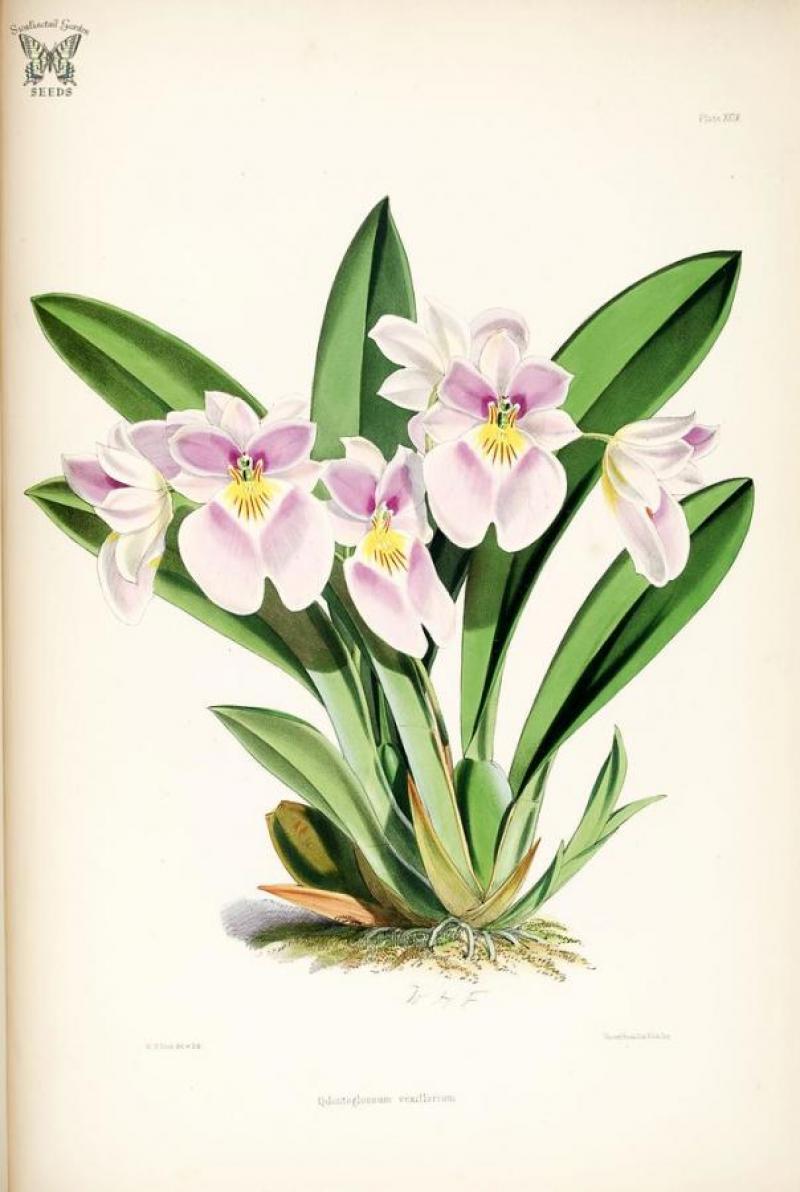Miltoniopsis vexillaria
Also known as: The Flag or Miltonia vexillaria h.v. kirsteiniae Miltonia vexillaria h.v. bellatula Miltoniopsis vexillaria h.f. alba Miltoniopsis vexillaria h.f. obscura Miltonia vexillaria h.v. chelsonensis Miltonia vexillaria h.v. lindeniae Miltoniopsis vexillaria h.f. lagrimosa Miltonia vexillaria h.v. superba Miltoniopsis vexillaria h.f. albescens Miltonia vexillaria h.v. leopoldiana Miltoniopsis vexillaria h.f. lineata Miltonia vexillaria h.v. vittata Miltonia vexillaria h.v. virginalis Miltonia vexillaria h.v. gloriosa Miltonia vexillaria h.f. alba Miltonia vexillaria h.f. tricolor Miltonia vexillaria h.f. lineata Miltonia vexillaria h.f. albescens Miltoniopsis vexillaria h.v. lambauenana Miltoniopsis vexillaria h.f. Carolina Miltoniopsis vexillaria h.v. superbum Miltoniopsis vexillaria h.v. virginalis Miltoniopsis vexillaria h.v. superba Miltoniopsis vexillaria h.v. gloriosa Odontoglossum vexillarium var. superbum Miltoniopsis vexillaria h.v. bicolor Odontoglossum vexillarium Miltoniopsis vexillaria h.v. belatula Miltonia vexillaria var. leopoldii Miltoniopsis vexillaria h.v. leucoglossa Miltonia vexillaria h.v. leucoglossa Odontoglossum vexillarium var. rubellum Odontoglossum vexillarium var. lehmannii Odontoglossum vexillarium var. purpureum Miltonia vexillaria var. stupenda Miltonia vexillaria var. rubella in the subfamily: Epidendroideae
Native to: Antioquia - Colombia Departamento del Huila - Colombia Ecuador
General Information
The Flag is a sympodial cool to warm growing epiphytic orchid belonging to the sub family Epidendroideae native to Colombia and Ecuador.
Plant Description
Sympodial. Grows to 30cm. Each new growth has a single lance shaped leaf that grows to 2-20cm long. Pseudobulbs grow to 1.8-3.8cm
Flowers
Numerous blossoms appear during Summer, Autumn and Spring
Blooming Season
- Autumn
- Spring
- Summer
Substrate(s)
- Coarse
- Bark
- Treefern
- Spaghnum Moss
- Perlite
Care Notes
These orchids like to be watered regulary, especially during warm weather, and prefer a well draining mix or also do well mounted, provided they can be watered daily or even many times a day.
These are quite a forgiving orchid, there are no special requirements to get this orchid to flower, just good care and consistent conditions. Larger plants may be more fussy and can react poorly to change; a poorly timed repotting, a pest infection or an unusually hot day can set them back for a couple of years. However, even plants that have been treated poorly can thrive, and if they are set back they often recover much stronger then they would otherwise be.
Climate
These orchids thrive in humid, cool, shady conditions with good airflow, they will be found under dense forest canopies where they will receive moderate sun exposure throughout the year.
When cultivated they will thrive in a cool, sheltered environment such as a shaded greenhouse, or if grown in cooler climates they can be grown in the garden in areas where they are protected from frost and receive shade throughout the year, though they may be able to tolerate some morning sun during winter.
Grows at high elevations. Rainfall ranges from 64mm to 196mm per day, heaviest in May and lightest in December. Humidity ranges from 69% to 77%, highest in October and lowest in January. Temperature ranges from 13C to 28C, highest in March (15C to 28C) and lowest in June (13C to 26C).Watering
These orchids prefer a wet-dry cycle between waterings, they should be watered frequently but only when the moisture is approaching dryness, where the pot feels light and/or the media looks dry. Keep an eye on mounted orchids in warm weather as they may dehydrate quickly.
Fertiliser
Apply liquid based fertiliser per recommended directions. They can benefit from a high phosphate fertiliser leading up to flowering season, followed by a high nitrogen fertiliser when new growth appears, and a balanced fertiliser in other times. These orchids can also tolerate slow release fertiliser applied 1-2 pellets per cup (250ml) of media.
Be sure to flush out excess fertiliser by running water through the media regularly year round. Apply fertiliser regularly at half strength year round. Use a high Nitrogen fertiliser during Spring and Summer. Use a high Phosphorous fertiliser during Summer.Potting
These plants are quite forgiving and will do well repotted ever 2-3 years. The mix should be coarse, well draining, and allow space for air to move and for roots to grow.
Alternatively, these plants will also do well mounted to tree fern or cork slabs, or mounted to trees.
Best time for repotting or mounting the orchids is the end of winter when new growths start to appear. Avoid repotting during hot weather,
Use water retentive media such as moss to prevent roots from drying out quickly This plant does well mounted. Repotting is best done annually and in a pot the same size or only slightly larger than the previous one.












